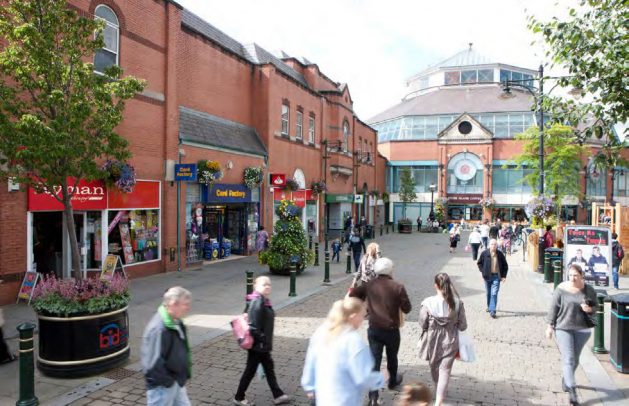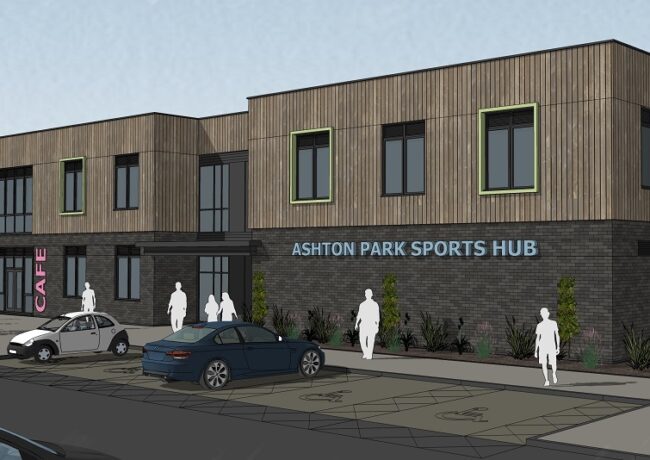The Subplot
The Subplot | Department stores, HS2, Oldham’s big bet
Welcome to The Subplot, your regular slice of commentary on the North West business and property market from Place North West.
This week: plans for Manchester’s House of Fraser raise hopes that the North West’s defunct department stores can find a new future. With the HS2 high speed line to Crewe now signed into law, Subplot asks if the town is all-aboard the workspace train. Meanwhile, Oldham Council pulls the threads together on the Spindles redevelopment.

ARE YOU BEING SERVED?
Department stores reborn
Investec’s plan to convert Manchester’s Kendal Milne building – or House of Fraser in new money – into a 500,000 sq ft office campus targeted at technology occupiers comes as North West landlords wonder what to do with dozens of defunct department stores. The answers could be surprisingly money-spinning.
The investor’s £300m rethink of the former Kendals store includes demolishing the rear car park to create a new development site, ground floor leisure and retail, and a start to work on site early next year. The move comes just weeks after Manchester City Council approved AM Alpha’s plans for the conversion of the former Debenhams in Market Street, where it will create 258,000 sq ft of offices on the upper three floors along with a 40,000 sq ft office extension on the roof. Both schemes edge forward as it emerges that John Lewis is mulling another eight department store closures. The need for action is urgent.
Thumbs up, mostly
Subplot discovered a few sceptics, but generally office developers and agents think that if Investec is patient, the Kendals plan could be a winner. They might be wise to move phase by phase, and must be watchful of competition from an ever-growing list other large tech-focused schemes such as Circle Square, Enterprise City, Noma and, of course, the Debenhams rebuild. The temptation to perform a quick flip, and over-optimism about the strength of the tech market, are the twin enemies. “They’re making a lot of assumptions here,” Subplot was told by a cautious tech sector insider. “Schemes like this need to land a lot of 50,000 sq ft requirements, and there aren’t that many of them about, while the big requirements that were floating around have gone very quiet.” Subplot has been told of two large Manchester tech requirements amounting to around 400,000 sq ft, both of which dropped off the radar last year. Pinning hopes on this kind of occupier can be risky.
Primark next?
If Kendals and Debenhams can be recycled for tech-themed workspace, why not Primark, which occupies the former 400,000 sq ft Lewis’s department store in Piccadilly? Primark trades on around 150,000 sq ft and has already looked at the possibility of converting the redundant upper floors (with maybe a few more added on top, à la Debenhams). The maths didn’t add up when Primark explored the idea in 2017/18, but if today’s sums work for Debenhams and Kendals, they might also compute for Primark, even if unlike other High Street retailers, it has yet to launch an online operation. Primark’s owner, Associated British Foods, is well-resourced, and, as it showed with its £70m, 160,000 sq ft Birmingham store, has no hang-ups about getting involved in property development. “Plans are being dusted off. Maybe this time round with a development partner,” Subplot was told. ABF did not respond to Subplot’s request to talk about the future of the building.
Not just tech
The focus on tech workspace should not obscure other options. The bioscience sector is high on the list of potential department store users, according to Savills’ Repurposing Retail research. This reveals that up to 100 London department stores or larger units could become laboratories, a potential total of 1.8m sq ft. There are live requirements maturing into deals in Oxford and Cambridge. Manchester and Liverpool cannot be far behind, although the list of potential locations is thin: the 185,000 sq ft Debenhams at Grosvenor’s Liverpool One is too big, and too prominent, and poses a more complicated problem. Dividing it up, with leisure use prominent, could be the answer as it has been with the also-prominent 80,000 sq ft Debenhams in Wandsworth, South London. “We are involved in a number of positive conversations with a range of potential new occupiers for the store, but it is too early to reveal any details,” a Grosvenor spokesperson told Subplot.
Money issues
However, not all department store landlords can afford to explore workspace or leisure conversion options, which often require terrific amounts of upfront capital. David Fox, Northern head of retail agency at Colliers International, says: “The bigger problems are those Noughties and Nineties shopping centres that depended on purpose-built Debenhams as footfall-drivers. For a number of those shopping centres the landlords frankly haven’t got the financial reserves you need to turn this round.”
The silver lining
The continuing stream of shopping centre administrations (last week, Preston St Georges) could be the unexpected key that unlocks redevelopment of redundant department stores. New owners are paying almost trivial sums to buy distressed centres. Capital values of £30/sq ft or less – often much less – make them extremely good value if, for instance, your defunct department store is conveniently located at the end of a mall. The new owner can simply chop the department store off, demolish and bingo, they have a town centre site worth a lot more than a Debenhams nobody wants.
Amputations
Fox says: “If you are paying virtually nothing for the shopping centre, the new owner only needs to find the cost of new development, and that is not so hard if you have continuing income from the rest of the shopping centre. There is real scope here to rip the centre up and start again.” Fox says cutting off the department store is like cutting off a gangrenous limb: it allows the rest of the centre to thrive or at least survive, and delivers a low-cost development site into the bargain.
Conclusion: Not every department store plan will fly, but a surprising number could. Now is not the time to give up on even the most apparently hopeless cases.
DRIVING THE WEEK
 Crewe and HS2: riding the slow train?
Crewe and HS2: riding the slow train?
Royal Assent for the HS2 Phase 2a Act means Crewe is now certain to get a new high-speed rail link. But sharper plans may be needed if the town is not to fumble the opportunity.
Cheshire & Warrington LEP is nurturing a 6m sq ft growth corridor from Crewe to Warrington. Office space will be concentrated in mixed-use development around Crewe’s HS2 rail station. There is, as yet, nothing more to say on this project. Cheshire East Council’s Crewe Hub Action Plan has been in suspended animation since March 2020. Is the paused strategy about to miss a trick?
Freight of expectations
If Turley’s Economics division is right (see Subplot, 26 January), and the yield from every 1m sq ft of warehousing is about 2,400 jobs, then the corridor strategy would produce about 14,000 jobs over its several years of life. But those jobs will owe more to the M6 and M62 than to rail, because rail freight capacity isn’t going to be the gamechanger some assume. Yes, getting passenger trains off the West Coast Mainline produces more slots for freight trains, but only an additional 144 a day over the entire UK network (which manages around 600 daily). Many of them won’t come anywhere near Crewe. Yet the town will suddenly be a super-rapid commute from Birmingham or Manchester (if services are offered) and just 56 minutes from London. That’s as close as Oxford and closer than Brighton according to this calculator. This is why many in the town believe that if there are any quick or certain gains from the arrival of HS2 they will be found in the office market.
Small but beautiful
Today’s Crewe office market is modest but, as design-and-build demand shows, if the wind was blowing in the right direction it could be bigger and busier. Right now, the market for anything resembling modern space is remarkably tight, as proved this month by mobile phone refurbish and recycle business Brightstar. When space unexpectedly became available at Orbit Development’s Gawsworth House, Crewe Business Park, it grabbed 12,000 sq ft. Separately, the last business park site is heading down the design-and-build route, with a 40,000 sq ft to 50,000 sq ft scheme pending, and there is just one promising refurbishment prospect (the 51,000 sq ft Futjitsu office, Infinity House) and it will not mature until 2023. The same dynamics apply in the also super-tight Nantwich market. What holds the market back is a lack of sites, and rents at levels miles away from making speculative development viable.
It’s all about money
Brightstar paid £14.50/sq ft. A refurbished Fujitsu building could work at somewhere between £16 and £17.50/sq ft, but to make new-build work needs £18-20/sq ft, and a lease of 10 years or more, which is a scarcity in this market. Crewe is trapped in a chicken-and-egg dilemma: rents won’t rise until someone builds spanking-new Grade A, and nobody will do that until rents rise. The public sector could break the loop by taking a wrap-around lease, or offering gap funding. Paul McLeman, leasing director at Orbit Developments, recommends it gives it a try. “Cheshire East should look at what Stockport have achieved with Stockport Exchange and, in essence, copy what they have done, because it works,” he says.
The HS2 hub
The obvious place to build and where the LEP is focusing its plans is around the HS2 station/existing railway station, but that isn’t as easy as it sounds. Some sites could be repurposed, others are long shots – it is all fairly tight and there’s probably only 50,000 sq ft of obvious wins to be had. Andy Butler, Nantwich-based director at Legat Owen, says: “Landowners are holding back to see what’s happening.” Orbit’s McLeman adds: “Finding the right sites for new offices will be challenging as Crewe’s a funny place – the station isn’t really in the town centre, the existing business park is well-established and prominent but is essentially out of town. There’s lots of terraced housing round the existing station, it’s not brilliant, with disparate ownerships, and it will be difficult to pull it all together.” Crewe Town Board has applied for £25m from the Government’s Towns Fund, which might help. So, what are the options for office development?
Overlooked
The selection of development sites for the Cheshire East Plan is underway: consultation closed at the end of December. The draft list of strategic employment sites doesn’t offer much for the office market, with the emphasis instead falling squarely on industrial and warehouse provision. New office options begin and end with about an acre at Meadow Bridge, Crewe. The March 2020 draft of the Crewe Hub Action Plan points to a digital-enabled commercial core focused on Weston Road, while “mixed-use residential-led office schemes” would be supported at Mill Street and “office-led mixed-use residential development” (spot the difference) in the commercial hub. Macon Way would see “prominent” commercial development, including offices. There are no floorspace numbers, and the Action Plan has been lost in action since March 2020.
If not now, when?
Asked if there are any prospects for early office market development, Legat Owen’s Butler says: “I’d like to say ‘yes’, but I can’t see anything coming through. Offices have been left behind. What we need is a 30,000 sq ft building with smaller floorplates for the small and mid-size businesses, because that is what Crewe is good at attracting, because we can’t wait until HS2 comes along.”
Watch this space
In a statement to Subplot, Cheshire East Council said: “The Crewe Hub Area Action Plan…includes our ambition to deliver office space in close proximity to the station. Meanwhile, the council has received an ‘in principle’ offer of £14.1m from the Government’s Future High Streets Fund over the next three years. Included in our proposals are plans for the creation of two new workspaces to help new/early-stage technology businesses to establish and grow.”
Conclusion: Crewe’s office market will never be massive, but it could be bigger if the public sector grabs the opportunity. Will it?
IN CASE YOU MISSED IT…
 Developers heart Oldham
Developers heart Oldham
Oldham Council is seeking a development partner for its ambitious town centre rethink. The plans, focused on the Spindles shopping centre, are getting a surprisingly warm response.
Paying £9.5m for a 450,000 sq ft shopping centre was an “absolute bargain”, according to Oldham Council leader Cllr Sean Fielding. At just £21/sq ft, he wasn’t wrong. The rock-bottom capital cost, and continued shopping centre income, means the council can afford to entirely rethink the Spindles. As well as hosting a relocated Tommyfields market (cost £8m-£10m) the centre will be redeveloped to include new council offices (cost unknown), and new commercial flexible workspace (cost £8m). The old brutalist Civic Centre gets replaced with residential as part of the redevelopment merry-go-round.
Warm response
The reaction among developers has so far has been warm – very warm – not least because this is the last serious town centre redevelopment opportunity in Greater Manchester, and offers the kind of cost-earnings balance now totally unattainable in Manchester city centre. The usual names are in the frame. Top of the list is Muse Developments, which already has the Bolton, Stockport, and Salford cards in its hands, and appears to be intent on collecting the full GM Happy Families set. “An underexplored asset,” Subplot was told by one developer sniffing out the opportunities. Fielding also gets good reviews. The Oldham Town Investment Plan, published in December, wins praise for being practical and well thought-out. The exact size of the office requirement will be significant for the viability assessments, as will the status of the old Civic Centre. But everything depends on £41m of Government funding, which remains uncertain.
The Subplot is brought to you in association with Cratus, Bruntwood Works and Savills.






HS2 is still about sucking energy from the north to the south. Looking for benefits from HS2 in some modest uptick in the Crewe office market is akin to being grateful for the small crumbs off of a London centric investment strategy. With that kind of sympering and fawning to the pro London investment mindset – “levelling up” is going to be the same as the “northern powerhouse”. A set of political marketing slogans that benefit no one beyond a few regeneration consultants tasked to write some positive thought pieces about the “potential” they have to deliver change.
What a depressing sham.
By Northern Cynic
All HS2 will do is bring London commuters to cheaper housing causing a local price increase pricing locals out of the market.
By Paulxrn